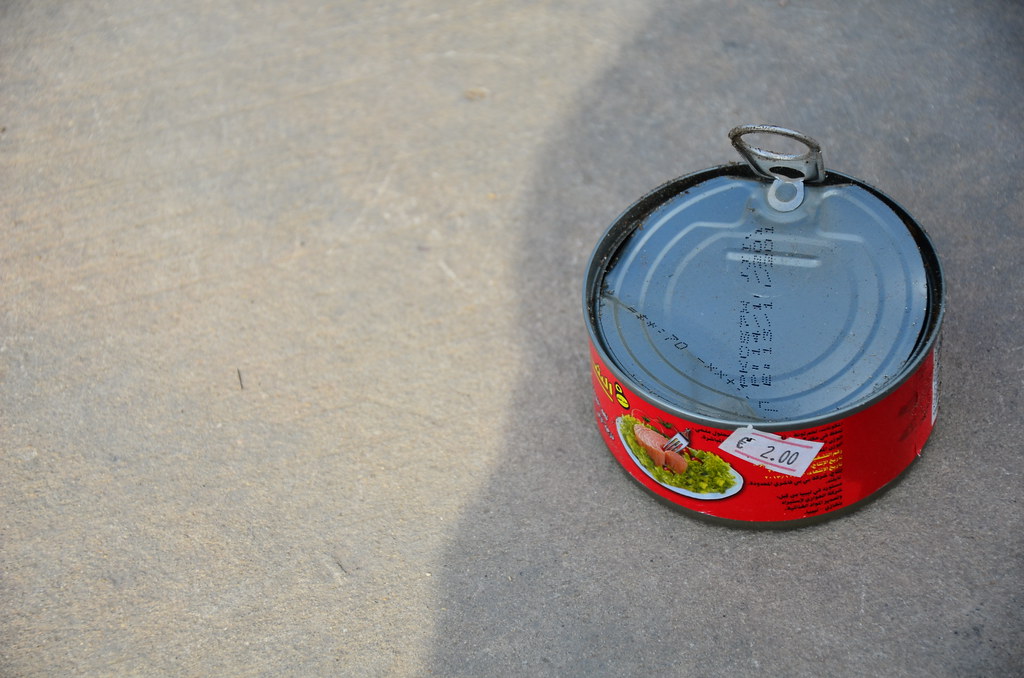
Of all the foods that attract bluebirds, live mealworms are definitely bluebirds’ favorite! The good news is that you don’t need to start off with an expensive mealworm feeder in order to attract bluebirds. In this article, I’m going to show you how to make the easiest and cheapest mealworm feeder for bluebirds that actually works! Here’s how to attract bluebirds with a simple tuna can and a nail.
To attract bluebirds with a tuna can and a nail, find a clean and dry metal tuna can. Nail the tuna can to the top of a wooden fence post (or fasten it securely with a 3M strip) with the opened side facing up. Then, fill the can with live mealworms and let the bluebirds start to find them!
Photo above by Ben Sutherland is licensed under CC BY 2.0.
The simple tuna can feeder works so well because it’s basically a miniature platform feeder, which bluebirds love to use. In this rest of this article, I’ll show you step-by-step how I set up one of these feeders, and I’ll answer some other important questions (like where to place the feeder so that bluebirds will actually find it!)
As a DIY feeder, this is a cheap and easy project to get started with. But, if you’re looking for a more high quality mealworm feeder to add to your backyard, click here to see the one that I use and recommend on Amazon.
How to Attract Bluebirds with a Tuna Can and a Nail – Step-by-Step
1. Clean and dry a metal tuna can (or cat food can)
Start by cleaning and drying a small aluminum food can for this feeder. The best types of cans to use are tuna cans and old cat food cans. You’re looking for a can with a wide base and short sides. A bean can would be too tall, for example, since the birds would have a difficult time standing on the edge and bending down to pick food up off of the bottom. So, go with a tuna can!
First, remove the lid from the can, then clean the inside, and dry it out completely. Now you’re can is ready to use in the next step.
2. Nail the tuna can to a wooden fence post
Next, get a standard nail, about two or three inches long. Secure the tuna can to the top of a wooden fence post by nailing the can through the bottom into the top of the post. Sure, having a feeder attached to a metal pole would be more ideal for a long-term solution. But, this is just a quick and easy bird feeder, so nailing a can to a wooden fence post will work just fine.
If you don’t want to nail a permanent hole into the top of your fence post, you can secure the tuna can to the post using a super sticky, 3M-brand strip.
Once you’ve got the tuna can securely fastened to the fence post, it’s time to fill it with food.
3. Fill the tuna can with live or dried mealworms and wait for bluebirds to find them!
Now, fill the open tuna can with a handful of live mealworms. (Dried mealworms will work too, but bluebirds are more attracted to live mealworms since they wiggle and wriggle around.)
You can usually find bags of live mealworms in the refrigerated section at hardware stores or bait shops. For a cheaper option, you can also order them online. Click here to check the current prices on Amazon.
If bluebirds are familiar with your backyard, you can expect them to discover your new tuna can mealworm feeder within a few days. And, once they know where to find the mealworms, don’t be surprised if they follow you around when you are outside expecting you to refill the tuna can!
Usually, bluebirds will sit on the edge of the can and pick bluebirds out one-by-one with their beaks. Sometimes they’ll stand off to the side on the fence post, if it is large enough, and empty the tuna can from the side. Either way, they’ll love the new feeder you’ve made for them!
FAQs: Attracting Bluebirds with a Tuna Can and a Nail
Where should I place my tuna can feeder so that bluebirds will find it?
You should place this mealworm feeder close, but not too close, to your bluebird nest box. (Closer than five feet away would probably be too close). This will make it easy for bluebirds to find the feeder, but the distance buffer will keep other birds from coming too close to the bluebird nest box.
Will other types of birds will use this feeder?
Other insect and worm-eating birds, like robins, chickadees, woodpeckers, and wrens, will likely find your feeder and use it too. Robins, in particular, love mealworms, and will become very “bossy” about controlling the feeder once they find it.
How can I stop other birds from using this feeder?
The only way to stop larger birds from using the feeder is to build some kind of structure around the feeder that keeps larger birds away. Jail Feeders and Gilbertson Feeders are two styles of mealworms feeders that were built with this in mind. However, the best thing to do is to build one of these feeders from the start. Or buy one online!
I have my own favorite wooden hanging mealworm feeder that I use which keeps larger birds out. Click here to check out that feeder on Amazon.
Conclusion: Attracting Bluebirds with a Tuna Can and a Nail
Attracting bluebirds to your backyard does not have to be extremely difficult. You can even make a successful mealworm feeder for your beloved bluebirds with nothing more than a used tuna can and a nail. It’s really that easy.
If you want to learn more about raising your own mealworms for bluebirds, read the article that I wrote here. And if you want to know more about what to feed bluebirds during the winter months, check out the article I wrote about that right here.

